Answered step by step
Verified Expert Solution
Question
1 Approved Answer
please answer parts f,g, and h! parts a-e are complete 1 2 3 4 Vaughan Company had a fantastic sales 3rd Quarter Management had wanted
please answer parts f,g, and h! parts a-e are complete 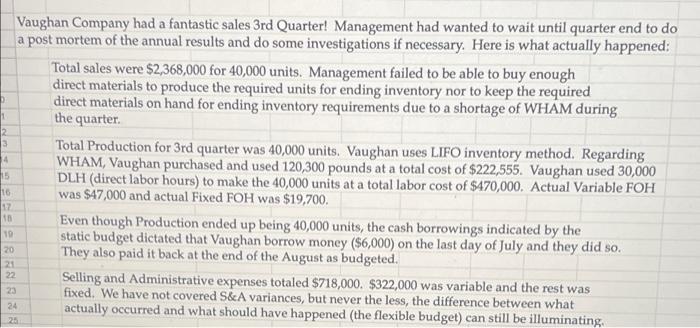
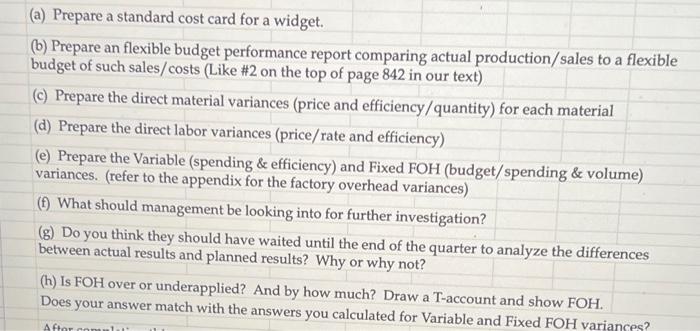

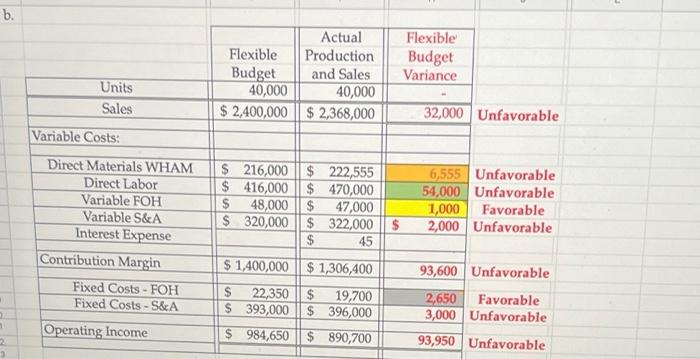
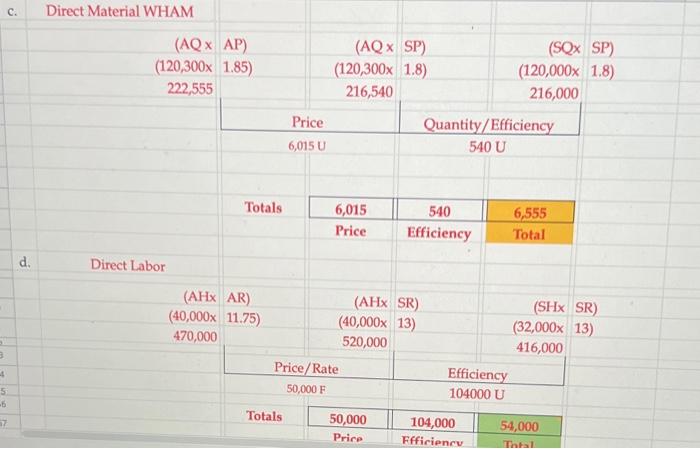
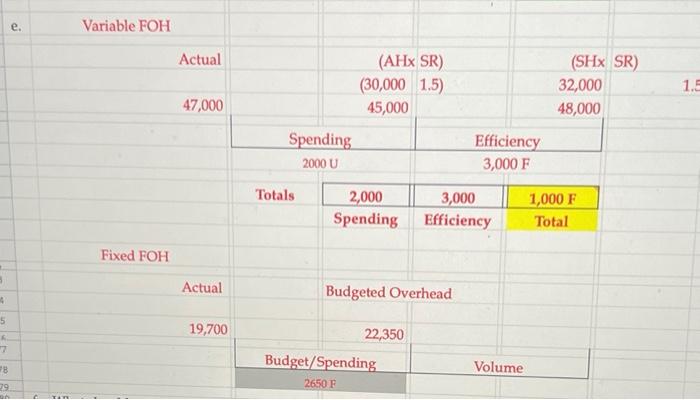
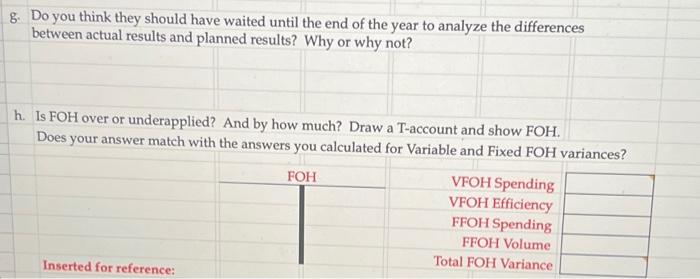
1 2 3 4 Vaughan Company had a fantastic sales 3rd Quarter Management had wanted to wait until quarter end to do a post mortem of the annual results and do some investigations if necessary. Here is what actually happened: Total sales were $2,368,000 for 40,000 units. Management failed to be able to buy enough direct materials to produce the required units for ending inventory nor to keep the required direct materials on hand for ending inventory requirements due to a shortage of WHAM during the quarter. Total Production for 3rd quarter was 40,000 units. Vaughan uses LIFO inventory method. Regarding WHAM, Vaughan purchased and used 120,300 pounds at a total cost of $222,555. Vaughan used 30,000 DLH (direct labor hours) to make the 40,000 units at a total labor cost of $470,000. Actual Variable FOH was $47,000 and actual Fixed FOH was $19,700. Even though Production ended up being 40,000 units, the cash borrowings indicated by the static budget dictated that Vaughan borrow money ($6,000) on the last day of July and they did so. They also paid it back at the end of the August as budgeted. Selling and Administrative expenses totaled $718,000. $322,000 was variable and the rest was fixed. We have not covered S&A variances, but never the less, the difference between what actually occurred and what should have happened (the flexible budget) can still be illuminating 15 16 17 16 10 20 23 22 23 24 25 a (a) Prepare a standard cost card for a widget. (b) Prepare an flexible budget performance report comparing actual production/sales to a flexible budget of such sales/costs (Like #2 on the top of page 842 in our text) () Prepare the direct material variances (price and efficiency/quantity) for each material (d) Prepare the direct labor variances (price/rate and efficiency) (e) Prepare the Variable (spending & efficiency) and Fixed FOH (budget/spending & volume) variances. (refer to the appendix for the factory overhead variances) (1) What should management be looking into for further investigation? (g) Do you think they should have waited until the end of the quarter to analyze the differences between actual results and planned results? Why or why not? (h) Is FOH over or underapplied? And by how much? Draw a T-account and show FOH. Does your answer match with the answers you calculated for Variable and Fixed FOH variances? After comman a Standard Cost Card Quantity Cost Total Direct Material WHAM Direct Labor Factory Overhead 3 0.80 0.80 X X 1.8 13 2.25 5.40 10.40 1.80 $ Total Cost (Variable: 1.50, Fixed: 0.45) 17.60 b. Actual Flexible Production Budget and Sales 40,000 40,000 $ 2,400,000 $2,368,000 Flexible Budget Variance Units Sales 32,000 Unfavorable Variable Costs: Direct Materials WHAM Direct Labor Variable FOH Variable S&A Interest Expense Contribution Margin Fixed Costs - FOH Fixed Costs - S&A $ 216,000 $ 222,555 $ 416,000 $ 470,000 $ 48,000 $ 47,000 $ 320,000 $ 322,000 $ $ 45 6,555 Unfavorable 54,000 Unfavorable 1,000 Favorable 2,000 Unfavorable 93,600 Unfavorable $ 1,400,000 $1,306,400 $ 22,350 $ 19,700 $ 393,000 $ 396,000 $ 984,650 $ 890,700 2,650 Favorable 3,000 Unfavorable Operating Income 2 93,950 Unfavorable C Direct Material WHAM (AQX AP) (120,300x 1.85) 222,555 (AQ SP) (SQx SP) (120,300x 1.8) (120,000x 1.8) 216,540 216,000 Quantity/Efficiency 540 U Price 6,015 U Totals 6,015 Price 540 Efficiency 6,555 Total d . Direct Labor (AHX AR) (40,000x 11.75) 470,000 (AHX SR) (40,000x 13) 520,000 Price/Rate 50,000 F (SHX SR) (32,000x 13) 416,000 Efficiency 104000 U 3 4 5 -5 Totals 7 50,000 Price 104,000 Ffficiency 54,000 . e. Variable FOH Actual (SHX SR) 32,000 48,000 1.5 (AHX SR) (30,000 1.5) 45,000 Spending 2000 U 47,000 Efficiency 3,000 F Totals 2,000 3,000 Spending Efficiency 1,000 F Total Fixed FOH Actual Budgeted Overhead 4 5 19,700 7 22,350 Budget/Spending 2650 F Volume B 39 g. Do you think they should have waited until the end of the year to analyze the differences between actual results and planned results? Why or why not? h. Is FOH over or underapplied? And by how much? Draw a T-account and show FOH. Does your answer match with the answers you calculated for Variable and Fixed FOH variances? FOH VFOH Spending VFOH Efficiency FFOH Spending FFOH Volume Total FOH Variance Inserted for reference: 1 2 3 4 Vaughan Company had a fantastic sales 3rd Quarter Management had wanted to wait until quarter end to do a post mortem of the annual results and do some investigations if necessary. Here is what actually happened: Total sales were $2,368,000 for 40,000 units. Management failed to be able to buy enough direct materials to produce the required units for ending inventory nor to keep the required direct materials on hand for ending inventory requirements due to a shortage of WHAM during the quarter. Total Production for 3rd quarter was 40,000 units. Vaughan uses LIFO inventory method. Regarding WHAM, Vaughan purchased and used 120,300 pounds at a total cost of $222,555. Vaughan used 30,000 DLH (direct labor hours) to make the 40,000 units at a total labor cost of $470,000. Actual Variable FOH was $47,000 and actual Fixed FOH was $19,700. Even though Production ended up being 40,000 units, the cash borrowings indicated by the static budget dictated that Vaughan borrow money ($6,000) on the last day of July and they did so. They also paid it back at the end of the August as budgeted. Selling and Administrative expenses totaled $718,000. $322,000 was variable and the rest was fixed. We have not covered S&A variances, but never the less, the difference between what actually occurred and what should have happened (the flexible budget) can still be illuminating 15 16 17 16 10 20 23 22 23 24 25 a (a) Prepare a standard cost card for a widget. (b) Prepare an flexible budget performance report comparing actual production/sales to a flexible budget of such sales/costs (Like #2 on the top of page 842 in our text) () Prepare the direct material variances (price and efficiency/quantity) for each material (d) Prepare the direct labor variances (price/rate and efficiency) (e) Prepare the Variable (spending & efficiency) and Fixed FOH (budget/spending & volume) variances. (refer to the appendix for the factory overhead variances) (1) What should management be looking into for further investigation? (g) Do you think they should have waited until the end of the quarter to analyze the differences between actual results and planned results? Why or why not? (h) Is FOH over or underapplied? And by how much? Draw a T-account and show FOH. Does your answer match with the answers you calculated for Variable and Fixed FOH variances? After comman a Standard Cost Card Quantity Cost Total Direct Material WHAM Direct Labor Factory Overhead 3 0.80 0.80 X X 1.8 13 2.25 5.40 10.40 1.80 $ Total Cost (Variable: 1.50, Fixed: 0.45) 17.60 b. Actual Flexible Production Budget and Sales 40,000 40,000 $ 2,400,000 $2,368,000 Flexible Budget Variance Units Sales 32,000 Unfavorable Variable Costs: Direct Materials WHAM Direct Labor Variable FOH Variable S&A Interest Expense Contribution Margin Fixed Costs - FOH Fixed Costs - S&A $ 216,000 $ 222,555 $ 416,000 $ 470,000 $ 48,000 $ 47,000 $ 320,000 $ 322,000 $ $ 45 6,555 Unfavorable 54,000 Unfavorable 1,000 Favorable 2,000 Unfavorable 93,600 Unfavorable $ 1,400,000 $1,306,400 $ 22,350 $ 19,700 $ 393,000 $ 396,000 $ 984,650 $ 890,700 2,650 Favorable 3,000 Unfavorable Operating Income 2 93,950 Unfavorable C Direct Material WHAM (AQX AP) (120,300x 1.85) 222,555 (AQ SP) (SQx SP) (120,300x 1.8) (120,000x 1.8) 216,540 216,000 Quantity/Efficiency 540 U Price 6,015 U Totals 6,015 Price 540 Efficiency 6,555 Total d . Direct Labor (AHX AR) (40,000x 11.75) 470,000 (AHX SR) (40,000x 13) 520,000 Price/Rate 50,000 F (SHX SR) (32,000x 13) 416,000 Efficiency 104000 U 3 4 5 -5 Totals 7 50,000 Price 104,000 Ffficiency 54,000 . e. Variable FOH Actual (SHX SR) 32,000 48,000 1.5 (AHX SR) (30,000 1.5) 45,000 Spending 2000 U 47,000 Efficiency 3,000 F Totals 2,000 3,000 Spending Efficiency 1,000 F Total Fixed FOH Actual Budgeted Overhead 4 5 19,700 7 22,350 Budget/Spending 2650 F Volume B 39 g. Do you think they should have waited until the end of the year to analyze the differences between actual results and planned results? Why or why not? h. Is FOH over or underapplied? And by how much? Draw a T-account and show FOH. Does your answer match with the answers you calculated for Variable and Fixed FOH variances? FOH VFOH Spending VFOH Efficiency FFOH Spending FFOH Volume Total FOH Variance Inserted for reference 






Step by Step Solution
There are 3 Steps involved in it
Step: 1

Get Instant Access to Expert-Tailored Solutions
See step-by-step solutions with expert insights and AI powered tools for academic success
Step: 2

Step: 3

Ace Your Homework with AI
Get the answers you need in no time with our AI-driven, step-by-step assistance
Get Started


